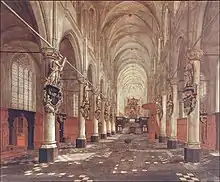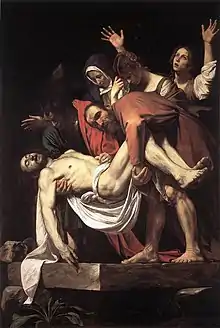The Elevation of the Cross (Rubens)
The Elevation of the Cross (also called The Raising of the Cross) is the name of two paintings, a very large triptych in oil on panel and a much smaller oil on paper painting.[1] Both pieces were painted by the Flemish artist Peter Paul Rubens in Antwerp, Belgium, the original in 1610 and the latter in 1638.[1]
| The Elevation of the Cross | |
|---|---|
 | |
| Artist | Peter Paul Rubens |
| Year | 1610–11 |
| Medium | Oil on wood |
| Dimensions | 462 cm × 341 cm (182 in × 134 in) |
| Location | Cathedral of Our Lady, Antwerp |
The original is in the Cathedral of Our Lady, as the church for which it was painted has been destroyed. The smaller version is now in the Art Gallery of Ontario, Canada. Another smaller triptych with a different composition, and an oil study, are in the Louvre in Paris.

Peter Paul Rubens painted the triptych The Elevation of the Cross after returning to Antwerp from Italy in 1610-1611 as commissioned by the church authorities of the Church of St. Walburga.[1] Cornelis van der Geest, a wealthy merchant and churchwarden of the Church of St. Walburga, secured this commission for Rubens and funded the majority of the project.[1] Under Napoleon's rule, the emperor took the painting, along with Peter Paul Rubens's The Descent from the Cross, to Paris.[2] The paintings were returned to Antwerp in 1815, but since St. Walburga had been destroyed, they were placed in the Cathedral of Our Lady in Antwerp instead.[2]
The Antwerp triptych was positioned above the high altar preceded by a set of stairs, making it visible from a great distance in the vast Gothic cathedral of St. Walburga.[3] This height was unusual for an altarpiece indicating its important presence in St. Walburga.[3] While it was present in St. Walburga, the painting was surrounded on all sides by images of God the Father, Christ, angels, and at the top of the structure was a wood pelican, which was a common representation of Christ's sacrifice based on a folk lore associated with the bird feeding its young with its own blood.[3]
Visual analysis

Jesus Christ and the elevation of his cross are the focal points for this artwork, with features of the story overflowing from the middle panel onto the wings on both sides.[1] This altarpiece is an early attempt by Ruben's to employ the intensity of the Baroque style.[4] The setting is dark and restless as the group of spectators, soldiers, horses, and the strained bodies of the executioners surround the soon-to-be crucified Christ.[4] Jesus' body is a picture of classical nobility; with arms raised and gaze turned upward, Rubens emphasizes Christ's willing sacrifice over the horrors of his crucifixion.[4] Christ's suffering is made apparent in his strained and tense body, hands clenched tight around the nails in his hands, and his head contorted in the last moments of agonizing pain.[4] The three panels together work harmoniously, creating a continuous scene.[1] The central panel illustrates a tension between the multitude of massively muscled men attempting to lift the cross and the seemingly unbearable weight of Christ on the cross.[1] In the left wing, the Virgin and Saint John are identified in a group of onlookers, horrified to see the executioners perform their duties.[1] The thieves in the right wing are being prepared for execution as the Roman officers issue their orders.[1]
Rubens also paints the outside of the wings, illustrating four saints that were venerated in Flanders during this time period.[1] On the far left stands St. Amandus clothed impressively in bishop robes, with St. Walburga positioned alongside him.[1] On the right outer wing stands Saint Catherine of Alexandria, accompanied by Saint Eligius.[1]
Influences


The work shows the clear influence of Italian Renaissance and Baroque artists such as Caravaggio, Tintoretto and Michelangelo.[1] Peter Paul Rubens's foreshortening is evident in the contortions of the struggling, strapping men, which is reminiscent of Tintoretto's Crucifixion in the Scuola di San Rocco in Venice.[1] Rubens's version creates a more compelling, intense and emotional response through the re-positioning of Christ.[3] Christ cuts across the central panel diagonally, akin to Caravaggio's Entombment where both descent and ascent are in play at a key moment. Rubens represents light with tenebrism, reflecting on the influence of Caravaggio.[3] Christ's perfectly molded body alludes to the nude figures painted by Michelangelo on the ceilings of the Sistine Chapel.[3]
The Council of Trent played a significant role in the subject matter and themes of Rubens's painting. Rubens emanates the spirit of the Counter-Reformation by representing the victorious nature of Christ's death while maintaining his divine nature.[3] The Elevation of the Cross is an accurate biblical representation of the crucifixion of Christ, in keeping with the specific guidelines for art as produced by the Council of Trent.[3]
The artists' workshop
Peter Paul Rubens was not fully responsible for the creation of this artwork, which is the reality for many of Rubens's paintings. The period after which Rubens arrived in Antwerp was a particularly busy time for the painter, and consisted of responsibilities beyond painting.[3] Rubens was head of a workshop that consisted of a hierarchy of pupils, assistants, and collaborators – all of which played an important role in the creation of the painting.[3] Rubens would have done all the sketches and designs for the works being created in his workshop.[3]

In terms of the Elevation of the Cross, Rubens started the creative process with oil and brush on a small panel. Also called a modello, this oil sketch served as a sample painting for the patron to approve the overall story and imagery, especially paying attention to the iconographic details.[3] The modello also served as a model for the assistants to start the preliminary steps of the full scale painting.[3] No major iconographic changes were made in the case of Rubens's Elevation of the Cross, but a few details such as the position of the cross were adjusted.[3]
The sketch was critiqued by the patrons, who preferred to put Christ in a more upright position as well as turning his body and face more towards the audience to heighten the drama of the piece.[3] Once the assistants had established the general composition, Rubens turned his attention towards the human figures. In this stage, Rubens used chalk to make drawings with live models present, positioning the models in the various poses as predetermined in the modello.[3] These separate drawings were used in conjunction with the modello in the final execution of the large scale painting.[3] Rubens made sure to touch up all the paintings once the assistants had completed their portion.[3]
Smaller version
The Elevation of the Cross is also the title of a smaller oil on paper painting reproduction of the triptych.[1] It measured 60 × 126.5 cm, but was later enlarged to 70 × 131.5 cm.[5] This smaller painting is a representative of modified reproduction of the much earlier triptych.[1] Also painted by Rubens, he completed the piece around 1638, and it was given to Hans Witdoeck, to use as a modello.[5] The smaller painting is unique from the original, however, with the addition of color accents throughout the composition.[5] The most notable difference seen between the 1611 painting and the 1638 painting is the elimination of the frames.[5] The removal of the breaks created a more cohesive scene.[5] Figures not seen in the earlier version are added, as well as some changes in the landscape.[5] Due to its size, some have suggested the painting may have been conceived as an independent painting to The Elevation of the Cross, to be given as a personal gift to Cornelis van der Geest.[5] The painting is now in the Art Gallery of Ontario's permanent collection, after it was purchased from George Holford in 1928.[6]
Notes
| Wikimedia Commons has media related to The Raising of the Cross by Rubens. |
- Martin, John (1969). Rubens: The Antwerp Altarpieces. New York, NY: Thames & Hudson Ltd. pp. 37–39. ISBN 0500460035.
- Dunton, Larkin (1896). The World and Its People. Silver, Burdett. p. 164.
- Belkin, Kristin (1998). Rubens. London, England: Phaidon Press. pp. 103–120. ISBN 9780714834122.
- Wedgwood, C.V. (1967). The World of Rubens, 1577-1640. New York: Time Incorporated, New York. pp. 58, 70. ISBN 0316510203.
- "Oil Sketches by Peter Paul Rubens". University of Berkeley. Retrieved 2 January 2018.
- Sutton, Peter C.; Wieseman, Majorie E.; van Hout, Nico (2004). Drawn by the Brush: Oil Sketches by Peter Paul Rubens. Yale University Press. p. 248. ISBN 0-3001-0626-2.
References
- Dunton, Larkin (1896). The World and its People. Silver, Burdett. p. 164
- Martin, John (1969). Rubens: The Antwerp Altarpieces. New York, NY: Thames & Hudson Ltd. pp. 37-39.
- Belkin, Kristin (1998). Rubens. London, England: Phaidon Press. pp. 103-120.
- Wedgwood, C.V. (1967). The World of Rubens, 1577-1640. New York: Time Incorporated, New York. pp. 58,70.
- Wiesman, Majorie. (2004). Drawn by the Brush: Oil Sketches by Peter Paul Rubens. Yale University Press. p. 248.